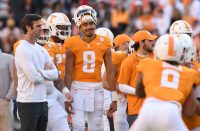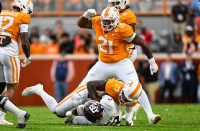In the weeks leading up to the season the last two years, we’ve put Tennessee’s outlook into tiers based on SP+ projections. Leading up to 2020, for instance, the most common comparisons were Tennessee teams you felt like had a realistic chance to have a shot every game. For this year, there was the hope of progress, and the idea that the Vols might not get blown out so often.
Tennessee’s final margin last night was 24 points, twice as many as what we saw in this match-up last year. But no one would argue which game was more competitive: last year Florida built a three-possession lead five plays and 75 yards into the third quarter, and the Vols didn’t score again until there were only five minutes left in the game, then down 31-7. So yes, the outcome was two possessions, but the experience was mostly non-competitive.
Last night, not only did the Vols build a 14-10 lead in the second quarter (and follow it up with a stop). But Tennessee had 4th-and-5 at the Florida 30 with six minutes to play in the third quarter, down 24-14. The drop by Jimmy Calloway was indeed crushing, turning what could’ve been a 24-21 game into a change in possession.
Tennessee also got Florida in 1st-and-20 a minute later, but couldn’t hold as the Gators converted 3rd-and-3, then 3rd-and-1 for a touchdown. The game went to three possessions with two minutes to play in the third quarter; Florida tacked on one more in the fourth.
But by this metric, Tennessee was in the game – ahead, tied, or behind by 1-2 possessions – for 43 of the game’s 60 minutes, or 72% of the outcome. And in this manner, the Vols showed immediate improvement.
In the last three years against the Gators:
- 2018: A safety and a 65-yard touchdown pass on the very next snap turned a 14-3 game into a 23-3 hole with 11 minutes to play in the second quarter. The Vols were in this game for 19 minutes.
- 2019: Florida scored on 4th-and-goal at the 1 on the final play of the second quarter for a 17-0 lead. Brian Maurer got the Vols downfield for three to open the third, but Florida answered with 75 yards in six plays to push it back to three possessions, and the Vols didn’t score again. Tennessee was technically in this game for 32 minutes, but failed to score a touchdown in 60.
- 2020: The Florida score to open the third quarter means the Vols were likewise in this game for 32 minutes.
Comparisons to Georgia and Alabama are increasingly unfair, but in the last administration, consider how quickly they built three-possession leads:
- 2018 Georgia: Dawgs up 17-0 on the last drive of the second quarter. Tennessee scored twice to get it back within 24-12 with 11 minutes to play, but Georgia ground us to death with a 13-play drive requiring nothing more than 3rd-and-4 to make it three scores again. Vols were in this game for 38 minutes.
- 2018 Alabama: Tua Tagovailoa hit Jaylen Waddle for 77 yards on the first play of Alabama’s third drive for the Tide’s third touchdown. Tennessee was in this game for all of seven minutes.
- 2019 Georgia: The one most similar to last night: Brian Maurer hit a big play and made a great throw to give the Vols a 14-10 lead early in the second quarter. Tennessee didn’t score again, but did have 1st-and-10 at midfield down 29-14 before throwing an interception, then stopped Georgia on fourth down but went three-and-out. The Dawgs made it three possessions with 8:02 to play in the fourth, putting Tennessee in this one for 52 minutes.
- 2019 Alabama: You know this one. Down 21-10 at the half, the Vols cut it to 21-13 in the third quarter. Bama responded with six, then the teams traded three-and-outs. The Vols had 4th-and-goal at the 1 with 7:21 to play when Jarrett Guarantano fumbled and Alabama ran it back for a touchdown. So the Vols were in this one for 52 minutes too.
- 2020 Georgia: Vols led 21-17 at halftime, then all Georgia. The Dawgs made it 16 points with 10:30 to go in the fourth, then scoop-and-scored to make it three possessions thirty seconds later. The Vols were in it for 50 minutes, but obviously it only felt like 30.
- 2020 Alabama: A second quarter score made it 21-3, but the Vols did answer with six. Bama was right back to work in five plays and 75 yards. The Vols were in this one for 24 minutes.
By this metric, Josh Heupel’s debut in a rivalry game was Tennessee’s best performance against the Gators in four years. And I’d put it on the list with the Brian Maurer Georgia game, the 2019 Alabama game until JG’s fumble, and the first half in Athens last year as one of Tennessee’s better performances in any rivalry game of the last three years.
This is, of course, no ultimate prize. But the Vols looked more coherent, longer, with fewer familiar faces. The game plan made sense on both sides of the ball. And so too, for now, did the outcome.
Tennessee moves to its most important stretch now, and will do so with continued uncertainty about the health of its quarterbacks. The Vols are +3 at Missouri, a virtual toss-up on a neutral field. The success of 2021 will rise and fall quite a bit between now and the next time we see one of our biggest rivals.
But for the long-term success of the program…last night was a decent step in the right direction, especially considering how many coaches have tried to take that first step over the last dozen years. There’s a lot left to learn. But not only could it have been a lot worse, it has been before. And there were signs that, perhaps, it might get better.
Go Vols.





I felt better about Heupel after Saturday night. I suppose it says something about the state of our program that I would feel better after failing to cover a huge spread against Florida, but here we are. I still have big concerns about his recruiting ability – if we can’t get the players in here then all the scheming in the world isn’t going to beat teams like Bama, Georgia, and Florida – but this staff appears to be able to game-plan and draw up plays that work. (It also unfortunately says something about the state of our program that… Read more »